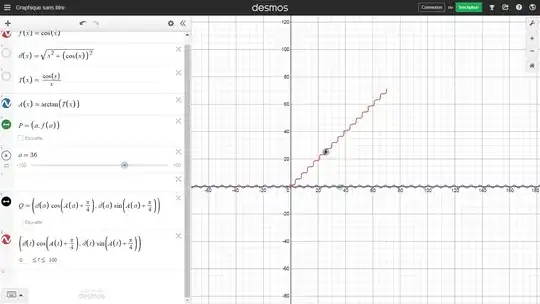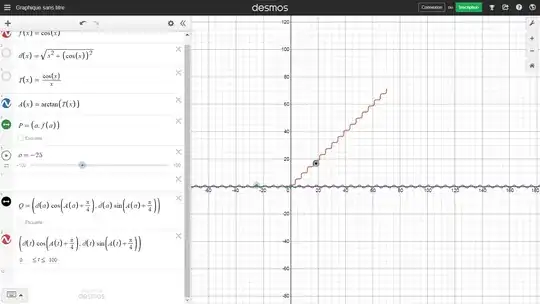As a pastime, I'm trying to rotate the graph of $f(x)=\cos(x)$ about the point $O=(0,0)$, and I chose, arbitrarily, a rotation of $\pi /4$ radians.
My question is : how comes the parametric equation I came up with only works for the part of the graph that is to the right of $O=(0,0)$?
I reasoned as follow : rotating the graph is tentamount to rotating each point $P=(x, f(x))$ by $\pi/4$ rd. on a circle ( one for each point) centered at $(0,0)$ and of radius $OP = \sqrt {x^2+f(x)^2}$.
So I defined the following auxiliary functions :
(1) Let $OP= d(x)= \sqrt {x^2 + f(x)^2}$
(2) Let $T(x)=$ slope of $OP = \cos(x)/x$
(3) Let $A(x)$= angle of $OP$ with the $X-$axis $= \arctan (T(x))$.
Inasmuch as each point $P$ is supposed to turn on a circle of radius $d(x)$ and of center $O$, trigonometry can be used which gives ( with $P'$ denoting the image of $P$ under the expected $\pi/4$ counterclockwise rotation) :
$X$ coordinate of $P'$ : $d(x)\cos(A(x)+\pi/4)$
$Y$ coordinate of $P'$ : $d(x)\sin(A(x)+\pi/4)$.
Hence the parametric equation :
$\bigg<d(t)\cos(A(t)+\pi/4), d(t)\sin(A(t)+\pi/4)\bigg>$
However, this parametric equation produces the desired result only for positive values of $t$ ( or of $x$).
Probably some feature of the $\tan(x)$ function could explain this, but I cannot identify which one it is.
here : a link to my attenpt using Desmos https://www.desmos.com/calculator/mjj6mnr55t
Below, an image for $x\gt 0$
Here , an image of what happens when $x\lt 0$ , point P is in green , its "image " under the parametric function is in dark grey.

